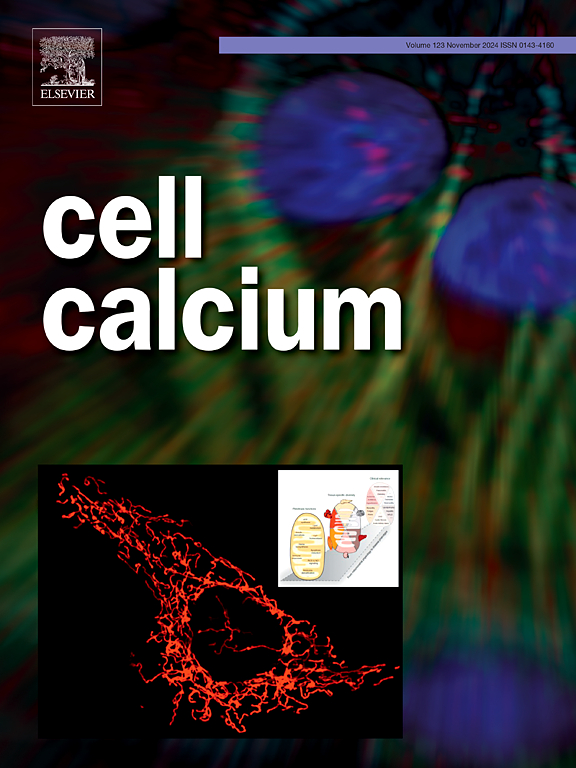GAT3-dependent regulation of glioma invasiveness via a lipid raft-associated PMCA4 Ca2+ transporter and a downstream CaMKII/CREB signaling – implications for compartmentalized signaling in glioma tumors
IF 4
2区 生物学
Q2 CELL BIOLOGY
引用次数: 0
Abstract
Emerging evidence underscores the crucial role of compartmentalized Ca²⁺ and GABA signaling in the development and progression of gliomas. Our findings reveal that low GAT3 expression and high PMCA4 levels are strongly associated with poor survival outcomes in glioma patients, suggesting their involvement in tumor progression. Using C6 glioma model, we uncovered a dynamic interaction between GAT3 and PMCA4 within lipid raft microdomains, which plays a key role in fine-tuning of localized Ca2+ dynamics in response to GABA stimulation. Knockdown of PMCA4 increased resting Ca2+concentration and enhanced Ca2+ accumulation in lipid rafts following 3-min pulse GABA stimulation, significantly impairing glioma cell migration and invasion. Interestingly, the expression of Ca2+ chelator parvalbumin in rafts abolished both baseline and GABA-stimulated Ca2+ rises, effectively restoring the migratory and invasive potential of tumor cells. We further demonstrated that GAT3 interacted with calmodulin, a pivotal regulator of PMCA4, and this interaction was decreased following 24 h GABA treatment. Long-term GABA stimulation also disrupted PMCA4/GAT3 complex, overloaded lipid rafts with Ca2+ and decreased glioma invasiveness in the presence of PMCA4. In these conditions, we observed GAT3- and Ca2+/calmodulin-dependent protein kinase II-dependent CREB phosphorylation at Ser133, which was controlled by Ca2+ events in lipid rafts and required to maintain glioma invasiveness. Our study uncovers a previously unrecognized GAT3-dependent mechanism of Ca2+compartmentalization in membrane microdomains, shedding new light on its potential role in tumor behavior. Understanding these local Ca²⁺ signaling partnerships will offer valuable insights into gliomagenesis and could lead to the development of novel therapeutic strategies for glioma treatment.

通过脂质筏相关的PMCA4 Ca2+转运体和下游CaMKII/CREB信号传导对胶质瘤侵袭性的gat3依赖性调节-对胶质瘤肿瘤区隔化信号传导的影响
新出现的证据强调了区隔化Ca 2 +和GABA信号在胶质瘤发生和发展中的关键作用。我们的研究结果表明,低GAT3表达和高PMCA4水平与胶质瘤患者的不良生存结果密切相关,表明它们参与肿瘤进展。利用C6胶质瘤模型,我们发现了脂筏微域内GAT3和PMCA4之间的动态相互作用,这在GABA刺激下局部Ca2+动力学的微调中起关键作用。在3分钟脉冲GABA刺激后,PMCA4的下调增加了静息Ca2+浓度,增强了脂筏中Ca2+的积累,显著损害了胶质瘤细胞的迁移和侵袭。有趣的是,筏中Ca2+螯合剂小白蛋白的表达消除了基线和gaba刺激的Ca2+升高,有效地恢复了肿瘤细胞的迁移和侵袭潜力。我们进一步证明GAT3与钙调蛋白相互作用,钙调蛋白是PMCA4的关键调节因子,并且这种相互作用在24小时的GABA处理后减少。长期GABA刺激也会破坏PMCA4/GAT3复合物,超载Ca2+脂筏,并降低PMCA4存在时胶质瘤的侵袭性。在这些条件下,我们观察到GAT3-和Ca2+/钙调素依赖性蛋白激酶ii依赖性CREB的Ser133磷酸化,这是由脂筏中的Ca2+事件控制的,是维持胶质瘤侵袭性所必需的。我们的研究揭示了一种以前未被认识的膜微域中Ca2+区隔化的gat3依赖机制,为其在肿瘤行为中的潜在作用提供了新的视角。了解这些局部Ca 2 +信号伙伴关系将为胶质瘤发生提供有价值的见解,并可能导致胶质瘤治疗新治疗策略的开发。
本文章由计算机程序翻译,如有差异,请以英文原文为准。
求助全文
约1分钟内获得全文
求助全文
来源期刊

Cell calcium
生物-细胞生物学
CiteScore
8.70
自引率
5.00%
发文量
115
审稿时长
35 days
期刊介绍:
Cell Calcium covers the field of calcium metabolism and signalling in living systems, from aspects including inorganic chemistry, physiology, molecular biology and pathology. Topic themes include:
Roles of calcium in regulating cellular events such as apoptosis, necrosis and organelle remodelling
Influence of calcium regulation in affecting health and disease outcomes
 求助内容:
求助内容: 应助结果提醒方式:
应助结果提醒方式:


